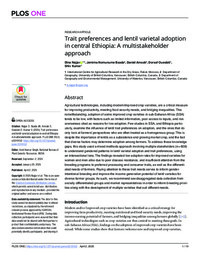Trait preferences and lentil varietal adoption in central Ethiopia: A multistakeholder approach

Authors:
Agricultural technologies, including modern/improved crop varieties, are a critical measure for improving productivity, meeting food security needs, and bridging inequalities. This notwithstanding, adoption of some improved crop varieties in sub-Saharan Africa (SSA) tends to be low, with factors such as limited information, poor access to inputs, and risk averseness cited as reasons for low adoption. Few studies in SSA, and Ethiopia particularly, examine the influence of lentil trait preferences on adoption, and the ones that do only look at farmers’ perspectives who are often treated as a homogenous group. This is despite the importance of lentils as a subsistence and growing market crop, and the fact that diverse factors may determine adoption among farmers. To address these knowledge gaps, this study used a mixed methods approach involving multiple stakeholders (n = 808) to understand gendered patterns in lentil varietal adoption and trait preferences, using an intersectional lens. The findings revealed low adoption rates for improved varieties for women and men alike due to poor disease resistance, and insufficient attention from the breeding programs to preferred processing and consumer traits, as well as the differentiated needs of farmers. Paying attention to these trait needs serves to inform gender-intentional breeding and improve the income generation potential of lentil varieties for diverse farmer groups. As such, we recommend sex-disaggregated data collection from socially differentiated groups and market representatives in order to inform breeding priorities along with the development of multiple varieties that suit different needs.
